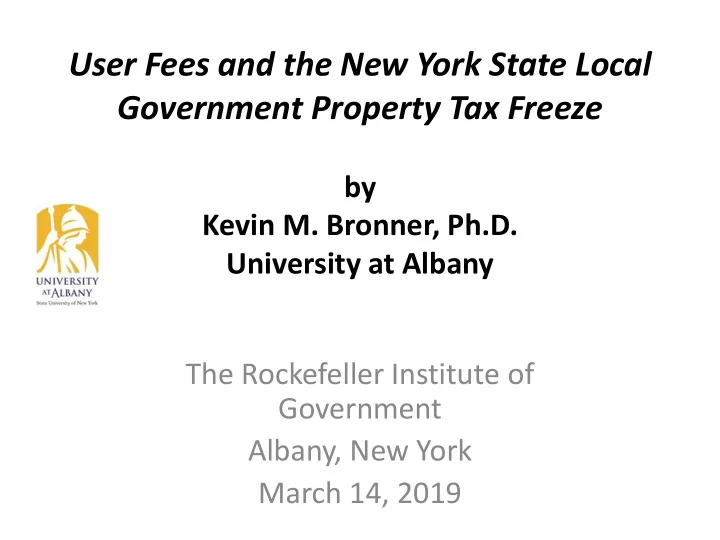

User Fees and the New York State Local Government Property Tax Freeze by Kevin M. Bronner, Ph.D. University at Albany The Rockefeller Institute of Government Albany, New York March 14, 2019
New York State Property Tax Cap • Started in 2011. • Limits property tax growth to two percent or the rate of inflation, whichever is lower. • Balanced budget still required. • Cap is not mandatory to any degree. • Property tax refunds and political pressure. • Special exclusions apply.
Special Exclusions • Employer contributions to pension systems. • Growth in the tax base. • Carry forward computation. • Court order related expenditures. • School district capital expenditures.
Some Governments Override the Cap • City of Troy had large 2017 tax increase to help fix a budget gap. • Town of Colonie budget for 2019 indicates they are above the cap limit on property tax revenues. Vote to override the cap in 2018.
Research Questions? • Did the implementation of a new property tax cap in 2011 by the State of New York have a systematic effect to encourage county governments to increase user fees and limit property tax revenues? • Did government spending activity for counties change after the cap was implemented?
Data for the Study • Office of the New York State Comptroller data for county governments. • Revenue patterns in 2010 to 2017 used. • Property tax revenue percent (2010 and 2017). • User fee revenue percentage (2010 and 2017). • Expenditure data (1996-2017)
Property Tax Reliance From 2010 to 2017 • Increased in 67% of counties (n=36). • Decreased in 33% of counties (n=18). • Missing data for 3 counties.
User Fee Reliance From 2010 to 2017 • Increased in 22% of counties (n=12). • Decreased in 78% of counties (n=42). • Missing data for 3 counties.
Counties Using More User Fees and Less Property Taxes • 8 Counties (14.8 percent) of 54 counties. • Four Large Counties: Erie, Monroe, Nassau and Suffolk. (Large Money Amounts). • Four Smaller Counties: Clinton, Rensselaer, Schenectady, and Wayne.
Data for 10 Largest Counties • Less reliant on property taxes: 50%. • More reliant on user fees: 50%. • Albany, Broome, Erie, Monroe, Nassau, Onondaga, Orange, Rockland, Suffolk, Westchester. • A “smaller county effect” influences that data when studied for all counties.
County Expenditure Study • 1996-2010: 4.9%. • 2003-2010: 4.9%. • 2011-2017: 1.0% • Research suggests lower spending associated with period after the cap was implemented.
Questions? • Request more information at kbronner@albany.edu.
Recommend
More recommend